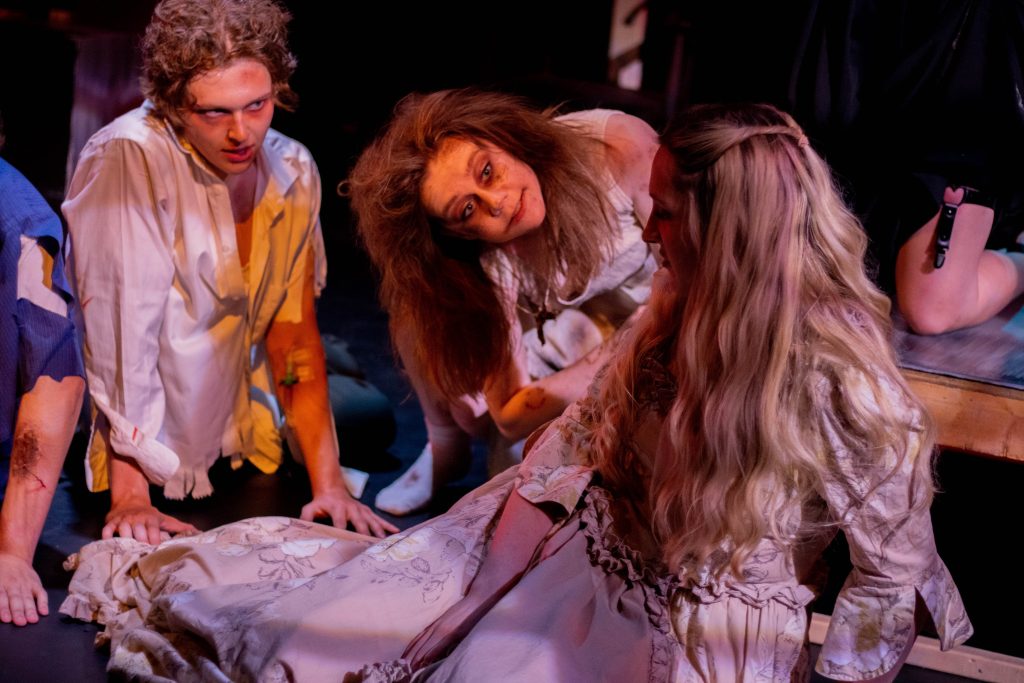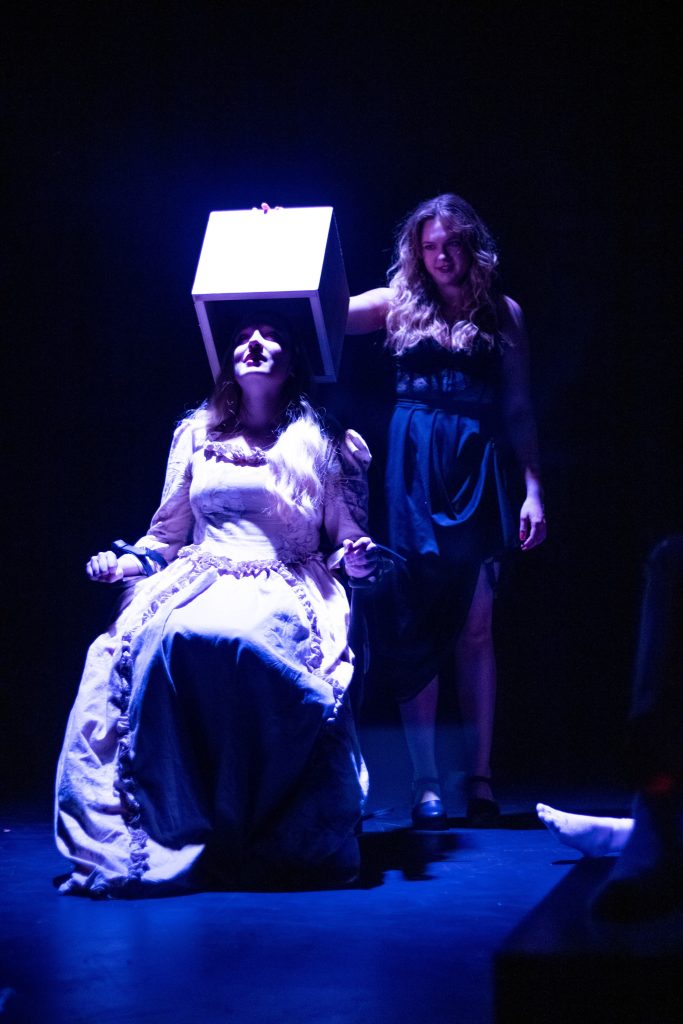Content warning: this article contains discussion of the institutionalization and mistreatment of individuals with mental disabilities.
On a Sunday afternoon in April, I found myself sitting in the Allen Bales Theater waiting for the final Crimson Stage show of the year, The Insanity of Mary Girard, to begin. With the house lights still up and the door open to the lobby, in walked a woman in late eighteenth-century clothing who was blindfolded and being led down the steps by five nightmarish spirits known as the Furies. They brought her to a chair positioned at the front of the stage, strapped her down and flipped a wooden box that was attached to the back of the chair over her head. The lights completely went out, except for a spotlight on the chair as Mary Girard let out a blood curling scream. And thus The Insanity began.
The Insanity of Mary Girard, written by Lanie Robertson, is a one-act play based on the real-life story of Mary Lum Girard. Born in 1758, Girard was the daughter of a Philadelphia shipbuilder, and in 1777 at the age of nineteen, married Stephen Girard, a prominent merchant. In August of 1790, her husband—and therefore legal guardian—had her declared a “lunatic” and committed her to the basement ward of the Pennsylvania Hospital. At the time, Mary was pregnant, though the identity of the father remains unknown. She would go on to give birth in the hospital and the baby would die five months later. Mary herself lived for another twenty, and was buried in an unmarked grave outside the Hospital grounds.
The play begins at the start of Mary’s stay where she was surrounded by the five Furies who would become physical manifestations of Mary’s struggle with mental illness and remain her only companions throughout the play. The Furies told Mary that they can show her anything she wants to know and then craft a nightmarish dream sequence where they morph into people from Mary’s past, present, and future. Perhaps the most monstrous of all, the only character not portrayed by a Fury, was Stephen.

Despite the production’s emphasis on constructing horrifying moments of dramatic effect through technical elements and the charged creepiness of the Furies, I found the most chilling moment to be a business transaction between Stephen and a representative from the hospital. Stephen—whose suit and slicked-back hair resembled a midcentury businessman—was informed by the representative that Mary was pregnant. The representative then told Stephen that keeping Mary in the ward would prove to be unsuitable conditions for her and the unborn child. Furthermore, he claimed that Mary’s illness may only be caused by her pregnancy, meaning that after the birth, her behavior would revert back to Stephen’s expectations of proper conduct for a wife. Stephen rejected the representative’s plea to remove Mary from the hospital, having already been aware of the illegitimate pregnancy. Instead, he offered the representative a check for three thousand dollars to purge any mention of the pregnancy from official records, along with promising vast sums of donations to the hospital upon the death of Mary and himself. In total, Stephen offered a sum worth roughly 1.33 million dollars in today’s money to keep Mary locked up.
What makes this scene so chilling is that it decimates any hope that Mary had for being released from the ward and demonstrates the utter lack of control that she possessed over her fate. The minimalism of this scene stands in stark contrast to the rest of the play with a strong white spotlight that cast down over a corner of the stage. Even just sitting at a desk, Stephen dominated the space. Quill in hand, he sealed the fate of his wife with the single flourish of a signature on a check, effectively conveying the effortlessness with which a woman’s rights can, were, and continue to be destroyed.

The power imbalance between the couple was underscored in their costuming. Mary was the only character dressed in period-accurate attire for the late eighteenth century, whereas Stephen wore a timeless business suit. The difference in costuming demonstrated that Mary was trapped because of her period’s treatment of women as property and belonging to their husbands. Stephen, however, was not tied to his period, despite the fact that he derived his absolute power over Mary from the laws and customs of the same era. This dichotomy demonstrates that the struggle for women’s autonomy extends beyond the historical setting of this play. Men like Stephen still exist today. They continue to silence women on the sole criteria of inconvenience. By having Stephen step out of his time period, he became so much more than just a cruel husband. He transformed into a symbol of the patriarchy’s continued dominance over women. That was more horrifying to me than any special effects could ever be.
Given the title, how did this play define “insanity”? For Mary, “insanity” was submission, an acceptance of circumstances, a letting go of the last shreds of resistance. In a moment of dramatic circularity, the play ended with Mary easily accepting the torture chair that she violently resisted at the beginning, declaring that “from this day forward I, Mary Girard, shall be truly and happily insane.” Yes, Mary chooses “insanity.” In a darkly ironic twist, this choice is the only moment where she succeeded in exerting control over her life. The paradox of Mary choosing the label of “insanity” is that it was both an act of submission and liberation. She submits to everyone’s expectations of her madness, and yet finds liberation in her ability to choose.
Perhaps Mary only possessed the illusion of choice? Maybe she had always suffered from a mental disability? It would certainly be a possible interpretation. I remain unconvinced that a psychoanalysis of Mary Girard is a worthwhile pursuit, however, nor do I really believe that The Insanity of Mary Girard is all that concerned with “insanity.” So, if The Insanity of Mary Girard is not about “insanity,” what then? Control. Simply put, this is a play where the audience watches a woman struggle for control over her mind, until she no longer does. With the resolution of the play, Mary broke the shackles of suppression by releasing her last grip on sanity. It does not matter if Mary’s choice is an illusion because she believes that she has the power to choose. Throughout the play, Mary fights for control and in the end, she finds it, even if it is not the kind of control she—and we—imagined.

The Insanity of Mary Girard was produced by Crimson Stage, April 22 to 23, 2023. Directed by Marissa Council, the cast included Lillie Boring (Mary Girard), Andrew Hines (Stephen Girard), Harrison Knapp (Fury 1/The Warder), Sophia Strickland (Fury 2/Mrs. Lum), Mary Clare Bone (Fury 3/Polly Kenton), Jackson White (Fury 4/Mr. Phillips), and Joleigh Bonds (Fury 5/Mrs. Hatcher). The production stage manager was Katie Harmon, with intimacy direction by Ashley White and movement coordination by Benton Davis; lighting and sound design by Marissa Council.

